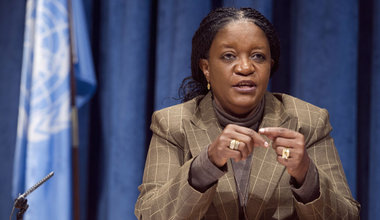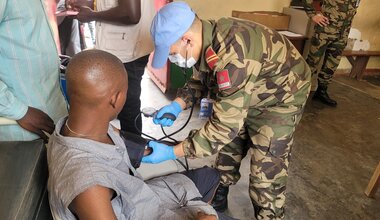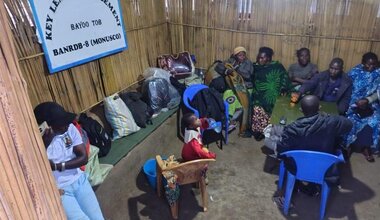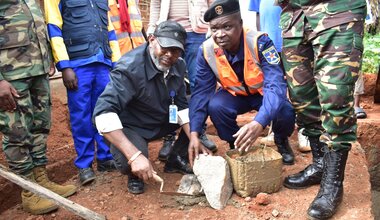New and Emerging Threats Require Renewed Fight against Sexual Violence in Conflict

By Zainab Hawa Bangura
An adolescent girl is kidnapped from her village in Iraq and she will be sold or given away to ISIL fighters as a sex slave. In a detention centre in Syria a man is sexually assaulted to punish him for his political affiliations, real or imagined. In South Sudan a woman must make the choice between feeding her family or being attacked by armed men when she tries to harvest crops. In Bosnia, a woman passes the place where she was raped every day during the war there twenty years ago. This is the reality for women, children and men around the world facing the threat of sexual violence in conflict.
This past year was one of tremendous progress in the fight against conflict-related sexual violence. In June 2014 the Global Summit to End Sexual Violence in Conflict in London brought together thousands of policy makers, researchers, civil society actors and survivors who made renewed commitments to eradicate this human rights violation. Countries that are grappling with conflict-related sexual violence delivered on some important commitments, with the Democratic Republic of Congo appointing a Presidential Representative on Sexual Violence in Conflict and the Recruitment of Children, and Colombia ensuring that survivors of sexual violence have a prominent place at the table as they negotiate a peace agreement to end that country’s decades long civil war.
But unfortunately, last year’s successes were also met with new and terrifying challenges. In April, the violent extremist group Boko Haram made headlines with their abduction of 276 schoolgirls from their dorm in Nigeria and their abuse of women and girls as a central belief of their doctrine. In August 2014 the Islamic State in Iraq and the Levant (ISIL) began targeting Yezidi women in northern Iraq, capturing them by the hundreds and forcing them into sexual slavery. The horrifying stories that began to emerge from young women who managed to escape painted a picture of unimaginable savagery and brutality, with some young women committing suicide rather than live in ISIL captivity.
These violent extremist groups are all the more frightening because of the organization and sophistication they use to subjugate and abuse women in areas under their control. They exploit them as prizes to reward fighters and then publicize these crimes on social media to attract new recruits. Their use of twenty first century technology amplifies their voices and helps to spread their medieval messaging to a global audience.
This year’s United Nations report on sexual violence in conflict documents horrendous crimes like this happening in conflicts around the world. It chronicles the disturbing trend of sexual violence against adolescent girls, including rape, sexual slavery and forced marriage. It records the use of sexual violence to persecute ethnic and religious minorities and the targeting of people based on their actual or perceived sexual orientation. It describes the heightened vulnerability of displaced and refugee populations to sexual abuse. It details the stigma and shame that keep women, men and children from coming forward when they have been attacked and outlines the lack of services and support available for the survivors who find the strength to speak out about what was done to them. The report lists 45 armed groups credibly suspected of committing these crimes, including state forces, opposition groups and violent extremist groups.
The report details the gruesome brutality that we face in the fight to end rape used as a weapon of war, but it also serves as a roadmap for solutions. By stressing the importance of building the capacity of civilian and military justice systems, the report underscores the necessary broader efforts required to strengthen institutional safeguards against impunity. For example, in the past year military and police officers, a number of them high-ranking, in countries covered by the report have been indicted, prosecuted, and convicted on charges of conflict-related sexual violence.
The report also highlights the need for sexual violence to be an element included in ceasefire and peace negotiations, and for perpetrators to be excluded from amnesty. It calls for more women peacekeepers to be deployed to conflict settings and increased participation of women in all peacekeeping and peacebuilding processes. Solutions include ensuring that the urgent need for increased medical, psychosocial, legal and economic services and support for survivors is met to help them rebuild their lives. National and regional early warning systems that sound the alarm against escalating sexual violence should be adopted to help prevent these atrocities before they occur.
The past year has shown that with political will and sustained action we can turn the tide against sexual violence in conflict. Despite this progress, the international community must renew its commitment and apply increased pressure so as not to lose the ground we have gained and to meet the demands of new and emerging threats.
Perpetrators of sexual violence in conflict are ruthless adversaries whose crimes can take many forms and require a comprehensive response. We must redouble our efforts to end impunity for perpetrators, to secure justice and reparations for victims and to strengthen the rule of law until innocent people are no longer menaced by this threat.
The challenges are great, but the lives of thousands of people around the world and the future peace and security of our global community are at stake. Losing this fight is not an option.
_____________________________________________________
Zainab Hawa Bangura is a United Nations Under-Secretary-General and the Special Representative of the Secretary-General on Sexual Violence in Conflict.
www.un.org/sexualviolenceinconflict
 UN
UN United Nations Peacekeeping
United Nations Peacekeeping





